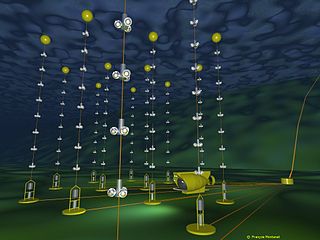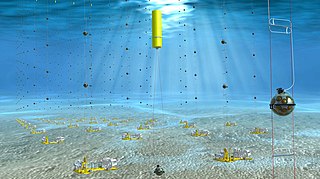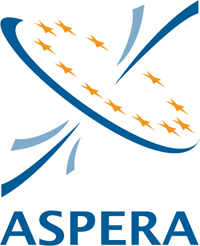
DESY, short for Deutsches Elektronen-Synchrotron, is a national research centre for fundamental science located in Hamburg and Zeuthen near Berlin in Germany. It operates particle accelerators used to investigate the structure, dynamics and function of matter, and conducts a broad spectrum of interdisciplinary scientific research in four main areas: particle and high energy physics; photon science; astroparticle physics; and the development, construction and operation of particle accelerators. Its name refers to its first project, an electron synchrotron. DESY is publicly financed by the Federal Republic of Germany and the Federal States of Hamburg and Brandenburg and is a member of the Helmholtz Association.
The French National Institute of Nuclear and Particle Physics, also known as CNRS Nucléaire & Particules, is the coordinating body for nuclear and particle physics in France. It was established in 1971 as a division of the French National Centre for Scientific Research (CNRS). Its purpose is "to promote and unite research activities in the various fields of physics".
The Max-Planck-Institut für Kernphysik is a research institute in Heidelberg, Germany.
The Supernova Cosmology Project is one of two research teams that determined the likelihood of an accelerating universe and therefore a positive cosmological constant, using data from the redshift of Type Ia supernovae. The project is headed by Saul Perlmutter at Lawrence Berkeley National Laboratory, with members from Australia, Chile, France, Portugal, Spain, Sweden, the United Kingdom, and the United States.

ANTARES is a neutrino detector residing 2.5 km under the Mediterranean Sea off the coast of Toulon, France. It is designed to be used as a directional neutrino telescope to locate and observe neutrino flux from cosmic origins in the direction of the Southern Hemisphere of the Earth, a complement to the South Pole neutrino detector IceCube that detects neutrinos from both hemispheres. The experiment is a recognized CERN experiment (RE6). Other neutrino telescopes designed for use in the nearby area include the Greek NESTOR telescope and the Italian NEMO telescope, which are both in early design stages. The data taking of ANTARES was finished in February 2022, after 16 years of continuous operation.

Laboratori Nazionali del Gran Sasso (LNGS) is the largest underground research center in the world. Situated below Gran Sasso mountain in Italy, it is well known for particle physics research by the INFN. In addition to a surface portion of the laboratory, there are extensive underground facilities beneath the mountain. The nearest towns are L'Aquila and Teramo. The facility is located about 120 km from Rome.
Astroparticle physics, also called particle astrophysics, is a branch of particle physics that studies elementary particles of astrophysical origin and their relation to astrophysics and cosmology. It is a relatively new field of research emerging at the intersection of particle physics, astronomy, astrophysics, detector physics, relativity, solid state physics, and cosmology. Partly motivated by the discovery of neutrino oscillation, the field has undergone rapid development, both theoretically and experimentally, since the early 2000s.

The Cubic Kilometre Neutrino Telescope, or KM3NeT, is a European research infrastructure located at the bottom of the Mediterranean Sea. It hosts the next-generation neutrino telescope with water Cherenkov detectors.

ASPERA is a network of national government agencies responsible for coordinating and funding national research efforts in astroparticle physics.
The Baikal Deep Underwater Neutrino Telescope (BDUNT) is a neutrino detector conducting research below the surface of Lake Baikal (Russia) since 2003. The first detector was started in 1990 and completed in 1998. It was upgraded in 2005 and again starting in 2015 to build the Baikal Gigaton Volume Detector (Baikal-GVD.) BDUNT has studied neutrinos coming through the Earth with results on atmospheric muon flux. BDUNT picks up many atmospheric neutrinos created by cosmic rays interacting with the atmosphere – as opposed to cosmic neutrinos which give clues to cosmic events and are therefore of greater interest to physicists.
The Laboratoire d'Annecy de physique des particules, usually abbreviated as LAPP, is a French experimental physics laboratory located in Annecy in the Haute-Savoie department of France. It is associated with both the French particle and nuclear physics institute IN2P3, a subdivision of the CNRS research council, and the Université Savoie Mont Blanc.
Large Apparatus studying Grand Unification and Neutrino Astrophysics or LAGUNA was a European project aimed to develop the next-generation, very large volume underground neutrino observatory. The detector was to be much bigger and more sensitive than any previous detector, and make new discoveries in the field of particle and astroparticle physics. The project involved 21 European institutions in 10 European countries, and brought together over 100 scientists.

Stavros Katsanevas was a Greek-French astrophysicist who was director of the European Gravitational Observatory, professor at the Université Paris Cité, former director of the AstroParticle and Cosmology (APC) laboratory and former chairman of the Astroparticle Physics European Consortium (APPEC). In 2000, he received for his work on supersymmetry the Physics Prize from the Academy of Athens. In 2011, he was awarded the Ordre National du Merite. He was an ordinary member of Academy of Europe, Earth and Cosmic Sciences since 2019.
Multi-messenger astronomy is astronomy based on the coordinated observation and interpretation of signals carried by disparate "messengers": electromagnetic radiation, gravitational waves, neutrinos, and cosmic rays. They are created by different astrophysical processes, and thus reveal different information about their sources.
Ramanath Cowsik is an Indian astrophysicist and the James S. McDonnell Professor of Space Sciences at Washington University in St. Louis. He is considered by many as the father of astroparticle physics. A recipient of the Shanti Swarup Bhatnagar Prize, Cowsik was honored by the Government of India, in 2002, with the fourth highest Indian civilian award of Padma Shri

Nicolao Fornengo is an Italian physicist. He is currently Full Professor at the University of Turin and he works on astroparticle physics, neutrino physics and cosmology.
Francis Louis Halzen is a Belgian particle physicist. He is the Hilldale and Gregory Breit Distinguished Professor at the University of Wisconsin–Madison and Director of its Institute for Elementary Particle Physics. Halzen is the Principal Investigator of the IceCube Neutrino Observatory at the Amundsen–Scott South Pole Station in Antarctica, the world's largest neutrino detector which has been operational since 2010.
Laura Baudis (1969) is a Romanian-born Swiss particle astrophysicist. She is employed as a full professor by the University of Zurich, Switzerland. Her research focuses on dark matter and neutrino physics. She is a member of the science strategy team for XENON as well as the CERN Scientific Policy Committee (2016–18) and the PSI Research Committee for Particle Physics.
Teresa Montaruli is an Italian astronomer specializing in neutrino astronomy, and in particular in the search for high-energy neutrinos from cosmic sources. She is a professor in the particle physics department at the University of Geneva.
Pierre Binétruy was a French theoretical physicist, known for his research on cosmology, gravitational waves, strong nuclear interactions, and supersymmetry.







